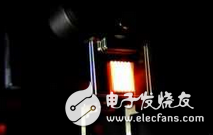A research team composed of the Massachusetts Institute of Technology (MIT) and Purdue University claims that researchers are successfully "combining the warm appearance of traditional light bulbs with the energy efficiency of the 21st century." Although the study belongs to the field of "nanophotonics", MIT researchers believe that the results of this research in light bulbs are also applicable to other energy conversion technologies.
The new structure developed by the researchers uses a conventional tungsten wire in a vacuum that, through the outer coating or surrounding the secondary structure, captures the radiation outside the visible light and reflects it back into the filament so that it can be absorbed again by visible light. Launch again. These photonic crystal structures are fabricated using abundant elements on Earth and traditional material deposition techniques: not only as reflectors for IR wavelengths, but also as bandpass or high-pass spectral filters for visible light. The heat is continuously returned to the filament and continues to accumulate as the resistance heating of the current increases the filament temperature.
The researchers pointed out that the program can theoretically achieve about 40% of the luminous efficiency, but the components manufactured so far are about 6%. However, this is comparable to compact fluorescent (CFL) and existing LED light sources.

According to MIT, “the incandescent lighting, warmth and familiar light have been around for more than a century, and have hardly changed in home applications around the world. However, as regulations continue to improve energy efficiency, they are rapidly The change is to phase out the old bulbs and switch to more efficient compact fluorescent lamps (energy-saving bulbs) and new LEDs."
The principle of an incandescent bulb developed by Thomas Edison is to heat the tungsten wire to a temperature of about 2,700 °C. The tungsten wire at this high temperature emits so-called black body radiation, an extremely wide spectrum that provides warm light and a variety of light sources. However, about 95% of the energy is dissipated by heat. This is why many countries have explicitly banned or eliminated such inefficient technologies. Today, researchers at MIT and Purdue University have found ways to reverse this.
New research results are published in the journal Nature Nanotechnology. According to the researchers, the key to this research is to establish a two-stage process. In the second step, "recycling" previously wasted energy, which allows the system to convert electrical energy into light energy more efficiently. One of them is to characterize the "luminous efficiency" of the light source, which must take into account the response of the human eye. Traditional incandescent lamps have a luminous efficiency of about 2-3%, while fluorescent lamps (including energy-saving bulbs) are 7-15%, and most LEDs are between 5-15%. Newly developed 2-stage incandescent lamps It is expected to achieve luminous efficiency of up to 40%.
However, the first proof-of-concept prototype developed by the research team has not yet reached this ideal, but is about 6.6% luminous efficiency. But even if this is a preliminary result, it can already match the current CFL and LED, and it may also increase the luminous efficiency of incandescent bulbs by 3 times.
One of the keys to the success of researchers is the design of a photonic crystal for a wide range of wavelengths and angles. Such photonic crystals are themselves fabricated by depositing a thin layer stack on a substrate.
“When you stack thin layers, you must use the correct thickness and order,†explains MIT professor Ognjen Ilic. “You can adjust the interaction between the material and the light source very efficiently. In the newly developed system prototype, the ideal visible wavelength Directly passing through the material, it is emitted by the bulb, but the infrared wavelength is reflected back to the filament like a mirror image, accumulating more heat and then converting it into light. Since only visible light can radiate, the heat continues to bounce back to the tungsten filament until it finally becomes Until the visible light."
In addition to light bulbs, the technology can be used to implement many other applications, said MIT professor Marin Soljacic. The same approach will have a "significant effect" on the energy conversion mechanism, such as a thermo-optical component, whose thermal energy comes from an external source (chemicals, sunlight, etc.) that causes the substance to illuminate, which can be transmitted through a photo-electric absorber. Emits light that can be converted into electrical energy.
Soljacic said: "Understanding the basic properties of various components", such as light, heat and its important interactions, and how the energy of light is used more efficiently is very important for a wide range of materials. In addition, the ability to control heat emissions is also critical. This is a substantial contribution to this research.
Compilation: Susan Hong (Reference original: MIT researchers resurrect the incandescent lamp with nano-tech, by Graham Prophet)
Operation Control Desk,Metal Sloped Operating Control Desk,Rittal Raked Operating Control Desk,Industrial Slanted Operating Control Desk
Huaian Qiangsheng Cabinet Co., Ltd. , https://www.qscontrolcabinet.com